When it comes to enjoying a day at the beach with your furry companion, prioritizing safety measures is key. From leash regulations to sun protection and water safety, there are crucial elements to consider for a secure beach outing.
By understanding the essentials of beach etiquette and canine well-being, you can ensure a pleasant experience for both your dog and other beach visitors.
Stay tuned to discover valuable insights and tips that will help you navigate the beach environment with your pet in a safe and responsible manner.
Key Takeaways
- Leash your dog for safety and control at the beach.
- Use long leashes for supervised water play and prevention.
- Provide sun protection, water, and shade for your dog.
- Stay vigilant, supervise water activities, and be prepared for emergencies.
Leash Safety Importance
Ensuring dogs are leashed at the beach is crucial for maintaining a safe and harmonious environment for all beachgoers. Leashed dogs prevent conflicts with other beach visitors, reducing the risk of unwanted interactions or disturbances.
By keeping dogs on a leash, owners can also prevent their pets from running into the ocean unsupervised, ensuring the safety of both the dogs and others enjoying the beach. Additionally, leashes help in controlling the movement of dogs, preventing them from wandering off or getting lost in unfamiliar surroundings.
Benefits of Long Leashes
Utilizing longer leashes at the beach allows dogs the freedom to play in the water while maintaining control and supervision over their activities. Long leashes can prevent dogs from running into the ocean unsupervised, ensuring their safety and the safety of others. Moreover, they enable owners to easily reel in their dogs if necessary without disrupting their beach experience. Here is a table summarizing the benefits of using long leashes at the beach:
| Benefits of Long Leashes |
|---|
| Allows freedom to play in the water |
| Ensures control and supervision |
| Prevents dogs from running into the ocean |
| Enables easy reeling in if needed |
| Enhances beach safety for dogs and others |
Beach Policy Check
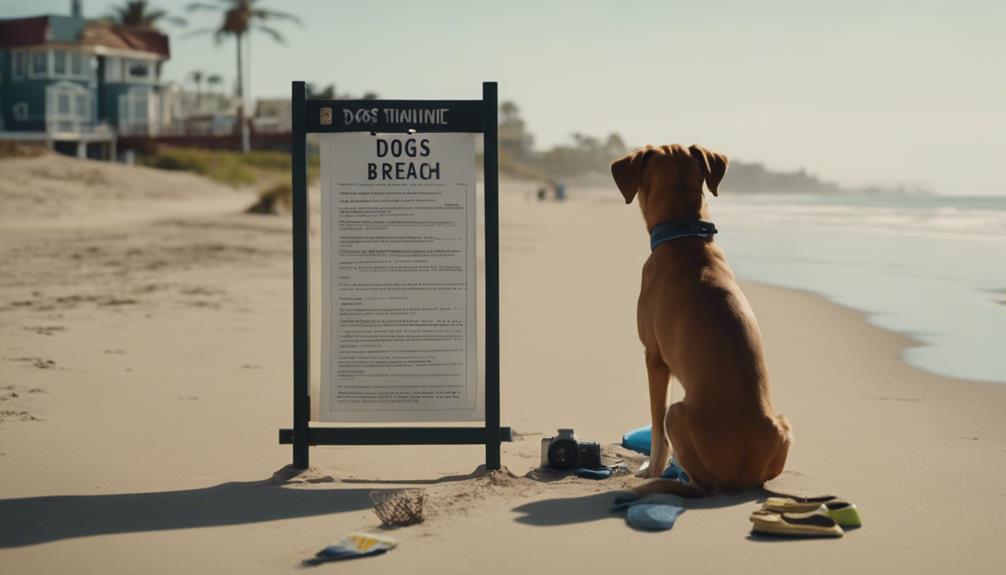
Before heading to the beach with your dog, it is essential to check the specific policies in place regarding dogs at the beach. Different beaches have varying rules concerning dogs, including whether they are allowed at all, leash requirements, designated dog-friendly areas, and any seasonal restrictions that may apply.
Some beaches may have specific times when dogs are permitted or prohibited, or they may have restrictions based on the size or breed of the dog. It is advisable to verify these regulations either by checking online resources related to the beach or by contacting the local authorities in charge.
Being aware of and following the beach policies ensures a safe and enjoyable experience for both you and your furry companion.
Awareness of Dog Regulations
When visiting the beach with your dog, understanding and adhering to dog regulations is imperative for ensuring a harmonious coexistence with other beach visitors and wildlife. It is essential to be aware of the following:
- Leash Laws: Keep your dog on a leash at all times to prevent conflicts and ensure the safety of others.
- Clean-Up Rules: Always clean up after your pet to maintain the cleanliness of the beach and protect the environment.
- Noise Regulations: Respect noise regulations to avoid disturbing other beachgoers and wildlife.
- Restricted Areas: Be mindful of any restricted areas where dogs are not allowed to maintain safety and compliance.
- Behavior Guidelines: Follow behavior guidelines to ensure a positive experience for everyone at the beach.
Sunscreen for Canines

Implementing sun protection measures for dogs, particularly through the use of sunscreen, is crucial for safeguarding their skin during beach outings. Just like humans, dogs can suffer from sunburns, especially those with short coats or light skin. When choosing sunscreen for your canine companion, opt for a pet-specific formula that is free of zinc oxide, which can be toxic to dogs if ingested.
Apply the sunscreen generously to hairless and vulnerable areas like the nose, ears, belly, and groin. Remember to reapply sunscreen after your dog goes for a swim to ensure continuous protection. Providing shade with an umbrella and access to cool water are additional ways to prevent sunburn and keep your furry friend comfortable at the beach.
Sun Protection Tips
To ensure your dog's skin remains protected from the sun's harmful rays during beach excursions, consider employing effective sun protection tips. Here are some essential tips to safeguard your furry friend:
- Apply dog-safe sunscreen to exposed areas.
- Use UV-protective clothing, like rash guards or hats.
- Seek shade during the peak sun hours.
- Offer plenty of fresh water to prevent dehydration.
- Consider protective eyewear for dogs with sensitive eyes.
Wildlife Awareness
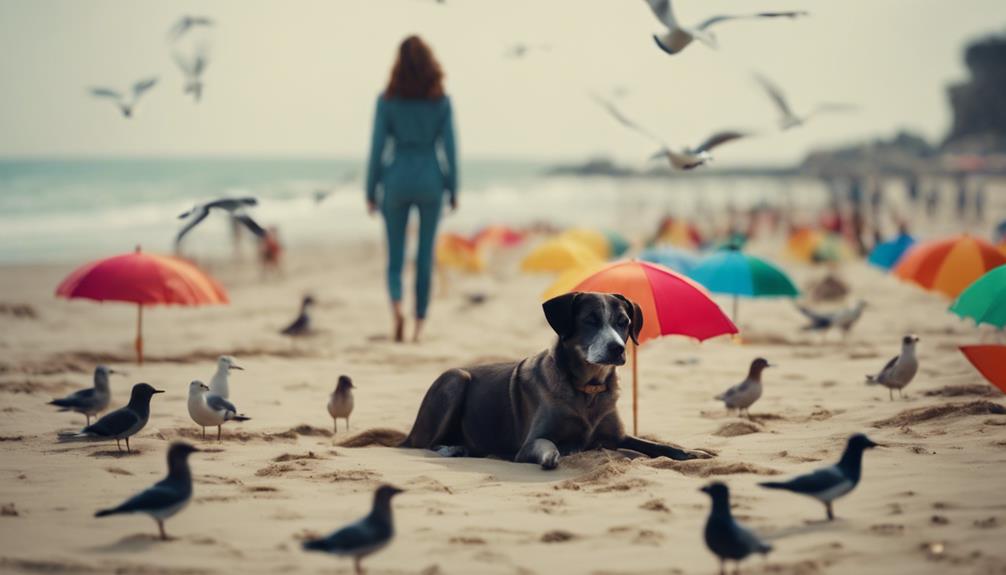
Considering the potential interactions with wildlife, staying vigilant and proactive is crucial for ensuring a safe and enjoyable beach outing with your dog. It's important to be aware of the wildlife that may be present on the beach to prevent any unwanted encounters. Here are some key points to keep in mind:
| Wildlife Awareness Tips | Description |
|---|---|
| Stay Alert | Keep an eye out for any wildlife such as birds, seals, or crabs. |
| Avoid Disturbing Wildlife | Do not let your dog chase or bother wildlife to prevent conflicts. |
| Respect Protected Areas | Be mindful of any designated protected wildlife areas on the beach. |
Precautions Against Wildlife
When navigating beach environments with your dog, prioritizing precautions against wildlife encounters is essential to ensure the safety of both your pet and local fauna. To safeguard your dog and the wildlife, consider the following measures:
- Keep a safe distance: Avoid approaching or allowing your dog to interact closely with wildlife.
- Observe signs of aggression: Be mindful of any signs of aggression from wildlife and move away calmly.
- Stay on designated paths: Stick to marked trails to minimize disturbances to wildlife habitats.
- Avoid feeding wildlife: Feeding wildlife can disrupt their natural behaviors and create dependency.
- Consult local guidelines: Familiarize yourself with specific wildlife precautions and regulations in the area to promote coexistence.
Water Safety Measures
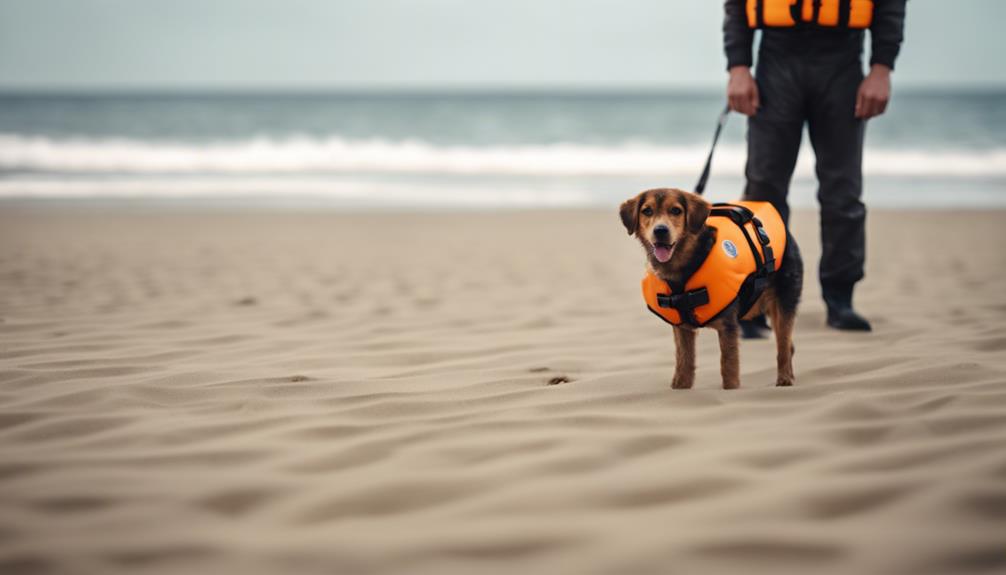
When enjoying a day at the beach with your dog, prioritizing water safety measures is crucial to ensure the well-being of your pet in aquatic environments.
Leashing your dog while near the water can prevent them from running into the ocean or getting into conflicts with other beachgoers. Using a long leash allows your dog to play in the water while maintaining control.
Be aware of beach policies regarding dogs, as some beaches may have specific regulations or restrictions. Keep a close eye on your dog's swimming abilities and supervise all water activities to prevent accidents.
Remember to call for help if your dog swims too far from shore, and be cautious of the effects of seawater on your pet's well-being.
Dog Swimming Evaluation
Assessing your dog's swimming abilities is essential for ensuring their safety in aquatic environments. Understanding whether your furry friend is a proficient swimmer will help you make informed decisions when at the beach.
Here are some key points to consider during your dog's swimming evaluation:
- Observation: Watch how your dog reacts to water and if they naturally start paddling.
- Buoyancy: Test your dog's ability to stay afloat and maintain a horizontal position in the water.
- Endurance: Assess how long your dog can swim comfortably without getting exhausted.
- Confidence: Notice if your dog shows enthusiasm for swimming or displays fear of the water.
- Safety Gear: Consider using a dog life jacket for added protection, especially for novice swimmers.
Supervising Water Activities
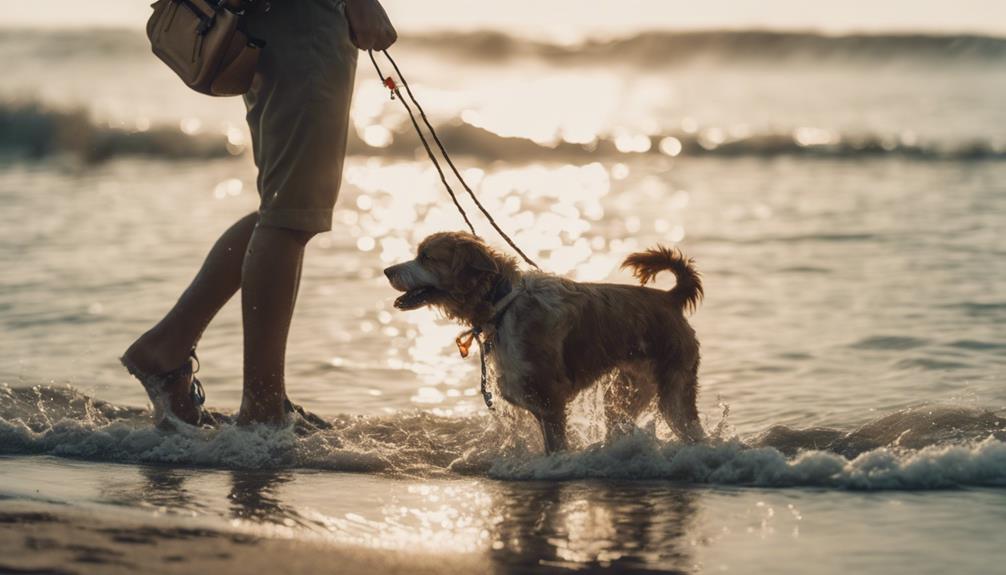
Effective supervision of water activities for your dog is crucial to ensure their safety and enjoyment at the beach. It's important to keep a close eye on your furry friend while they are in or near the water to prevent any accidents. Here is a table summarizing key points for supervising water activities with your dog:
| Supervision Tips | Description | Importance |
|---|---|---|
| Stay within arm's reach | Ensure quick assistance if needed | Safety of the dog |
| Watch for signs of fatigue | Look for slowing down or struggling | Prevent exhaustion |
| Monitor interactions with other dogs | Avoid conflicts or rough play | Socialization awareness |
Handling Swimmers in Distress
Supervision of water activities for your dog at the beach is essential, especially when it comes to handling swimmers in distress. It's crucial to be prepared for any emergency situation that may arise.
Here are some key points to consider:
- Always have a plan in place for rescuing your dog if they get into trouble in the water.
- Equip yourself with a flotation device that can aid in the rescue of your pet.
- Stay calm and focused to make quick decisions during a water rescue.
- Call for help from lifeguards or other beachgoers if needed.
- After a water rescue, ensure your dog receives proper care and attention to prevent any complications.
Effects of Seawater on Dogs
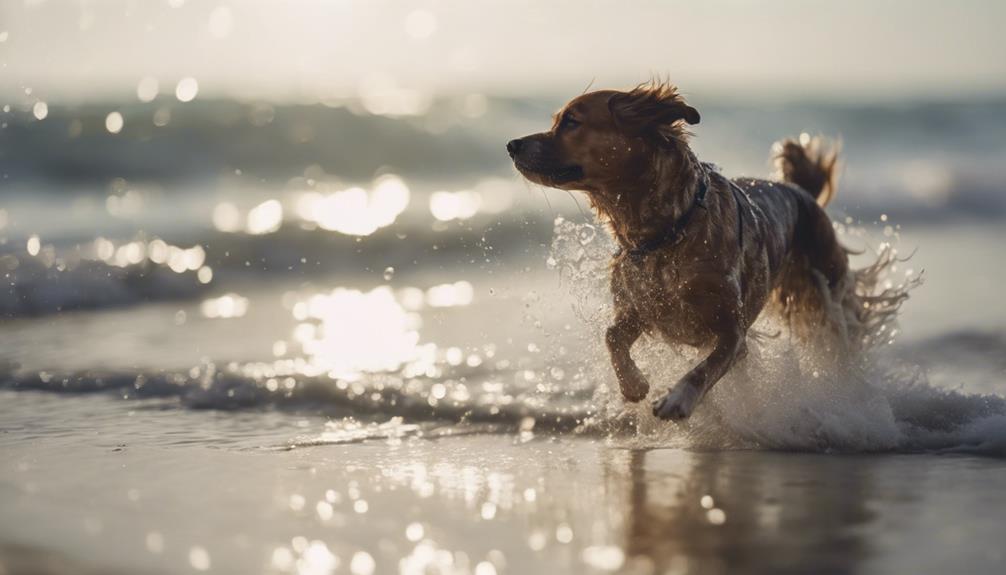
The impact of exposure to seawater on dogs' well-being and health is a critical aspect to consider when enjoying beach outings with your canine companion. Seawater can have both positive and negative effects on dogs, so it's important to understand how to keep your furry friend safe. Check out the table below for a summary of the effects of seawater on dogs:
| Positive Effects | Negative Effects |
|---|---|
| Provides exercise and fun for dogs | Ingestion can lead to salt poisoning |
| Can help with joint and muscle pain | Skin irritation and dryness |
| Cooling effect on hot days | Can cause gastrointestinal issues |
Remember to monitor your dog's interaction with seawater and ensure their well-being is a top priority during beach visits.
Ensuring Dog Beach Safety
Ensuring the safety of dogs at the beach requires diligent adherence to leash guidelines and awareness of beach policies. Following these guidelines will help keep your furry friend safe and ensure an enjoyable beach experience for everyone involved:
- Always keep your dog on a leash to prevent conflicts with other beachgoers.
- Check the beach policies regarding dogs before heading out to ensure they are allowed.
- Be mindful of wildlife in the area and keep your dog away to avoid any potential dangers.
- Supervise your dog closely in the water, especially if they are not strong swimmers.
- Provide sun protection for your dog with sunscreen, shade, and access to cool water to prevent sunburn.
Conclusion
In conclusion, prioritizing safety measures such as leash protocols, adherence to beach policies, sun protection, and monitoring water activities is essential for a secure and enjoyable beach outing with your canine companion. By following these guidelines and precautions, you can create a positive and responsible environment for both your dog and other beach visitors.
Stay informed, stay vigilant, and ensure a safe and harmonious experience at the beach with your furry friend.




